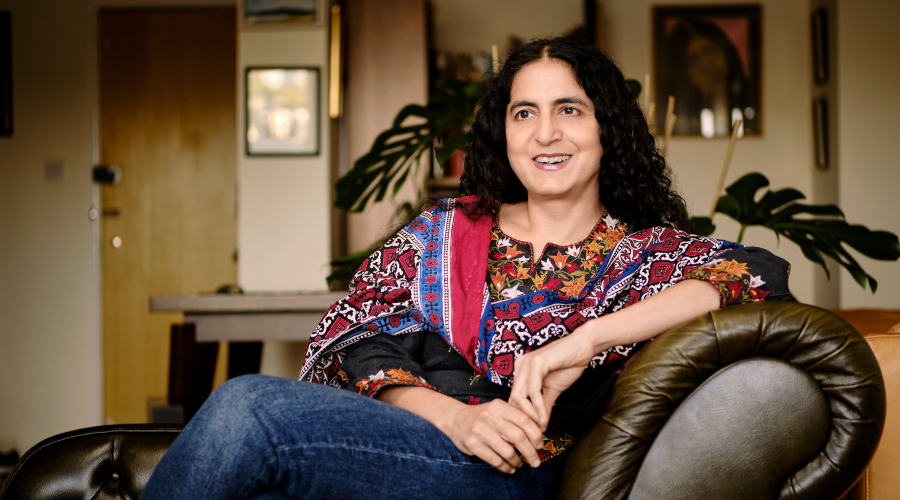Sapna Ajwani, the author of “Sindh: Sindhi Recipes and Stories from a Forgotten Land”, shares her love for her land, culture, and cuisine. The Sindhi people are not widely known, and someone had to tell their story.
Born and raised in Mumbai, Ajwani is a chartered accountant turned author. As the grandchild of Sindhi refugees who migrated to India after the Partition, her journey is driven by a deep desire to share the story of her community through rich flavours of Sindhi cuisine. A foodie since childhood, Ajwani loved bonding over delicious lunchboxes, making new friends all along the way. “I blame this on the foodie gene that I probably inherited from my grandfather,” she said, in a conversation with Outlook Traveller Eats. Despite being a humble academician, she reminisces about how her grandfather spared no expense when it came to Sindhi food like Seyal teevan (onion-braised meat), bhugal bhee (stir-fried lotus stem), and kheeme ji tikki with whisky.
While childhood made Ajwani a foodie, she realised the real essence of home-cooked food when she moved abroad in the early noughties. “When you leave home, the first thing you miss is the food,” added Ajwani. While working in Mumbai and later in London, she loved hosting her friends for delicious Sindhi dinners and became their quasi-food guide. Around the same time, supper clubs were making their way into London. The financial crisis had severely impacted the hospitality and restaurant sector, prompting a shift towards supper clubs. “I wanted to do something different from finance and explore what was in store for me,” said Ajwani. Her enthusiasm for food made her explore what supper clubs were, and she decided to try it herself. In 2016, Ajwani hosted her first supper club in London, taking a step closer to telling the story of the forgotten land.
Writing About ‘Sindh: The Forgotten Land’

“When we talk about Sindhi food, where do we place it? With no land of their own, it becomes a task for Sindhis to tell the world about their origin, culture and food,” said Ajwani. Her love for hosting and showcasing Sindhi cuisine, with encounters at the supper club, firmly sowed the seeds to write this book. “I was sure I wanted the book, not just an anodyne account of recipes, but a wholesome journey of telling stories of Sindhis,” she said. Writing about Sindh, the forgotten land, was also important because the children of the Partition, the generation who came here at the time, are all in their late 80s. Ajwani wanted to preserve all those stories. “This book was essential for me because I did not just want to talk to the people of Sindh, but people worldwide about Sindh,” she added.
She wanted to uncover the treasures of the ancient past of Sindh, speak to the community, uncover family recipes, and tell the world about them. “I was sure that I wanted to travel to Sindh for my research, and Priha Sayed, an Instagram follower, arranged everything for me to visit Sindh,” added Ajwani. She set out to explore the vibrant region of Sindh on her own, journeying from the serene Kinjhar Lake to the historic towns of Thatta and Hyderabad(Sindh), where her family used to live. “It was the most fascinating journey of my life, with tons of stories, warmth and hospitality that I will cherish my whole life.”
Recipes, Ingredients And Stories

“The Sindhi diet is a wholesome delight; it includes everything from pulses and vegetables to meat and fish, combining all the intrinsic tastes, savoury, sour, spicy and bitter,” said Ajwani. Known for their fusion, she tells how Sindhis love combining sweets with savoury dishes like seyun patata (sweet vermicelli with stir-fried spicy potato). Combining different textures is a distinctive quirk, like in daal pakwan (creamy daal with crispy pakwan). “In Larkano, Sindh, I discovered a unique preparation of Karela, stuffed with chana daal and keema”, added Ajwani. Another recipe was Acho bhod (chicken and meat in white gravy) from Rohri/Sukkur in northern Sindh. “It’s like safed maas from Rajasthan, with a pungent taste of white pepper and a creamy texture that lingers after the last bite.”









